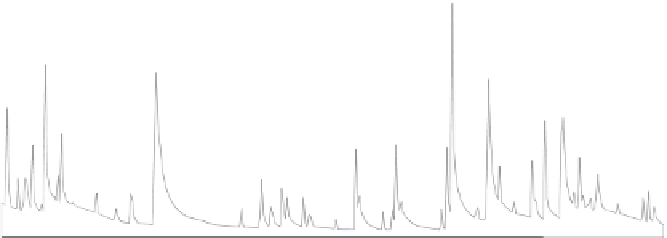Geography Reference
In-Depth Information
Figure 10.29. Runoff simulations
constrained by regionalised runoff
signatures for the Kirkbymills
catchment in the UK. Shown are
observed (black thick line) and
predicted runoff (grey range is
unconstrained and white range is
constrained). From Zhang et al.
(
2008a
).
40
Total range
Ensemble prediction
Observed
30
20
10
0
0
50
100
150
200
250
300
350
Time (days)
Advantages of the approach are its independence of a
hydrological model and that it is complementary to an
a-priori estimation of model parameters, similar to all
other methods that constrain the model parameters on
dynamic response data of the catchment (see below).
However, the performance of the method strongly
depends on how well the runoff signatures have been
regionalised.
1.0
0.8
0.6
0.4
Short runoff records in the catchment of interest
In his review on the subject in the Encyclopaedia of
Hydrological Sciences, Blöschl (
2005a
) noted:
0.2
'
It may
seem strange to end a review of rainfall
runoff modelling
in ungauged catchments with a note on the value of runoff
data, but that, in my opinion is the state of the science.
-
0.0
a priori
parameters
1 year
2 years
3 years
4 years
5 years
'
Since then, the use of short runoff records for estimating
model parameters in otherwise ungauged basins has
received renewed interest (e.g., Seibert and Beven,
2009
;
Tada and Beven,
2012
). Methods to constrain the model
parameters include calibration of hydrological models in
the spectral domain (Montanari and Toth,
2007
;
Winse-
mius et al., 2009
), which has the advantage that precipita-
tion and runoff data do not have to be available for the
same period.
A particularly interesting question is how many runoff
measurements are needed to obtain model parameters that
are not very different from those obtained from a longer
runoff record and give similar runoff predictions.
Perrin
et al. (2007)
found that 100
Figure 10.30. Effect of runoff record length used for model
calibration on the Nash
Sutcliffe runoff model performance for
the Seim catchment in central European Russia (catchment area
7460 km²). From Kuchment and Gelfan (
2009
).
-
flows. Accounting for long-term climate fluctuations is
more difficult (
Peel and Blöschl, 2011
) as the runoff
performance will not only depend on the number of
observations but on the time lag between the short runoff
record that is available and the period one is interested in.
Specifically,
Merz et al. (2011)
found for their study
region in Austria that the runoff simulation errors using
calibration parameters from short runoff records signifi-
cantly increased with the time lag. For median flows the
relative errors increased from 1 to 16% as the time lag
moved from 0 to 25 years, and for high flows the change
was from 9 to 25%. Clearly, long-term fluctuations in
runoff need to be carefully accounted for when estimating
runoff model parameters.
Chapters 5
,
8
and
9
of this topic
review methods of how this can be done for the case of
annual runoff, low flows and floods, and these methods
may provide some guidance also for the case of estimat-
ing runoff hydrographs from short records.
350 measurements were
needed, Seibert and Beven (
2009
) found this to be 32
measurements, while Kuchment and Gelfan (
2009
) and
Merz et al.(
2009
) found that three and five years of daily
runoff data were needed, respectively (
Figure 10.30
). It
appears that the number of measurements required
depends on how the measurements are distributed in time.
Perrin et al.(
2007
) and Seibert and Beven (
2009
) used
random sampling, while Merz et al.(
2009
) used consecu-
tive days, which explains the difference. Clearly,
-
it
is
important
that
the sampling covers both high and low









































Search WWH ::

Custom Search